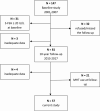Sleep during menopausal transition: a 10-year follow-up
- PMID: 33326582
- PMCID: PMC8193555
- DOI: 10.1093/sleep/zsaa283
Sleep during menopausal transition: a 10-year follow-up
Erratum in
-
Corrigendum to: Sleep during menopausal transition: a 10-year follow-up.Sleep. 2021 Dec 10;44(12):zsab211. doi: 10.1093/sleep/zsab211. Sleep. 2021. PMID: 34459918 Free PMC article. No abstract available.
Abstract
Study objectives: A 10-year observational follow-up study to evaluate the changes in sleep architecture during the menopausal transition.
Methods: Fifty-seven premenopausal women (mean age 46 years, SD 0.9) were studied at baseline and after a 10-year follow-up. At both time points, polysomnography (PSG) was performed, and the serum follicle-stimulating hormone (S-FSH) concentration was measured. Linear regression models were used to study the effects of aging and menopause (assessed as change in S-FSH) on sleep.
Results: After controlling for body mass index, vasomotor, and depressive symptoms, higher S-FSH level was associated with longer sleep latency (B 0.45, 95% confidence interval [CI]: 0.07 to 0.83). Aging of 10 years was associated with shorter sleep latency (B -46.8, 95% CI: -77.2 to -16.4), shorter latency to stage 2 sleep (B -50.6, 95% CI: -85.3 to -15.9), decreased stage 2 sleep (B -12.4, 95% CI: -21.4 to -3.4), and increased slow-wave sleep (B 12.8, 95% CI: 2.32 to 23.3) after controlling for confounding factors.
Conclusions: This study suggests that PSG measured sleep of middle-aged women does not worsen over a 10-year time span due to the menopausal transition. The observed changes seem to be rather age- than menopause-dependent.
Keywords: aging; follicle stimulating hormone (FSH); menopause; polysomnography (PSG); sleep architecture; sleep latency; slow-wave sleep (SWS).
© Sleep Research Society 2020. Published by Oxford University Press on behalf of the Sleep Research Society.
Figures



References
-
- Leger D, et al. . Prevalence of insomnia in a survey of 12,778 adults in France. J Sleep Res. 2000;9:35–42. - PubMed
-
- Young T, et al. . Objective and subjective sleep quality in premenopausal, perimenopausal, and postmenopausal women in the Wisconsin Sleep Cohort Study. Sleep. 2003;26:667–672. - PubMed
-
- Kravitz HM, et al. . Sleep difficulty in women at midlife: a community survey of sleep and the menopausal transition. Menopause. 2003;10:19–28. - PubMed
-
- Ohayon MM, et al. . Meta-analysis of quantitative sleep parameters from childhood to old age in healthy individuals: developing normative sleep values across the human lifespan. Sleep. 2004;27:1255–1273. - PubMed
Publication types
MeSH terms
Substances
LinkOut - more resources
Full Text Sources
Medical

